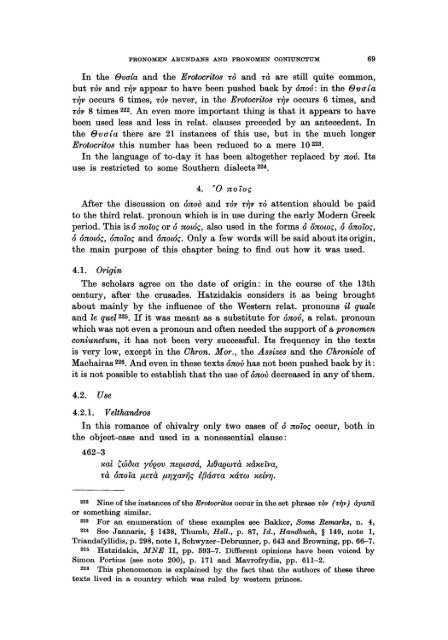Pronomen Abundans and Pronomen Coniunctum. A ... - DWC
Pronomen Abundans and Pronomen Coniunctum. A ... - DWC
Pronomen Abundans and Pronomen Coniunctum. A ... - DWC
Create successful ePaper yourself
Turn your PDF publications into a flip-book with our unique Google optimized e-Paper software.
PRONOMEN ABUNDANS AND PRONOMEN CONIUNCTUM 69<br />
In the evu{a <strong>and</strong> the Erotocritos 'l'O <strong>and</strong> 'l'à are still quite common,<br />
but 'l'OV <strong>and</strong> 'l'~V appear to have been pushed back by ónov: in the evu{a<br />
'l'~V occurs 6 times, 'l'OV never, in the Erotocritos 'l'~V occurs 6 times, <strong>and</strong><br />
'l'OV 8 times 222. An even more important thing is that it appears to have<br />
been used Ie ss <strong>and</strong> less in relat. clauses preceded by an antecedent. In<br />
the evu{a there are 21 instances of this use, but in the much longer<br />
Erotocritos this number has been reduced to a mere 10 223.<br />
In the language of to-day it has been altogether replaced by nov. lts<br />
use is restricted to some Southern dialects 224.<br />
4. '0 noioç<br />
Mter the discussion on ónov <strong>and</strong> 'l'OV 'l'~V 'l'O attention should be paid<br />
to the third relat. pronoun which is in use during the early Modern Greek<br />
period. This is ó noioç or ó notóç, also used in the forms ó önotOç, ó óno'ioç,<br />
ó ónotóç, óno'ioç <strong>and</strong> ónotóç. Only a few words will be said about its origin,<br />
the main purpose of this chapter being to find out how it was used.<br />
4.1. Origin<br />
The scholars agree on the date of origin: in the course of the 13th<br />
century, af ter the crusades. Hatzidakis considers it as being brought<br />
about mainly by the influence of the Western relat. pronouns il quaie<br />
<strong>and</strong> Ie quel 225 • If it was meant as a substitute for ónov, arelat. pronoun<br />
which was not even a pronoun <strong>and</strong> of ten needed the support of a pronomen<br />
coniunctum, it has not been very successful. lts frequency in the texts<br />
is very low, ex cept in the Ohron. Mor., the Assizes <strong>and</strong> the Ohronicle of<br />
Machairas 226. And even in these texts ónov has not been pushed back by it:<br />
it is not possible to establish that the use of ónov decreased in any of them.<br />
4.2. Use<br />
4.2.1. Velth<strong>and</strong>ros<br />
In this romance of chivalry only two cases of ó no'ioç occur, both in<br />
the object-case <strong>and</strong> used in a nonessential clause:<br />
462-3<br />
uai 1; ÓJdta yveov neetuuá, À,dJaew'l'à uàueiva,<br />
'l'à ónoia f-te'l'à f-t'YJXavijç èfJáu'l'a uá-rw ue{v'YJ.<br />
222 Nine of the instances of the Erotoeritos occur in the set phrase TOV (TT/V) dyaná<br />
or something similar .<br />
223 For an enumeration of these examples see Bakker, Some Remarks, n. 4,<br />
224 See .Jannaris, § 1438, Thumb, Hell., p. 87, Id., H<strong>and</strong>buch, § 149, note 1,<br />
Tri<strong>and</strong>afyllidis, p. 298, note 1, Schwyzer-Debrunner, p. 643 <strong>and</strong> Browning, pp. 66-7.<br />
225 Hatzidakis, MNE 1I, pp. 593-7. Different opinions have been voiced by<br />
Simon Portius (see note 200), p. 171 <strong>and</strong> Mavrofrydis, pp. 611-2.<br />
226 This phenomenon is explained by the fact that the authors of these three<br />
texts lived in a country which was ruled by western princes.
















